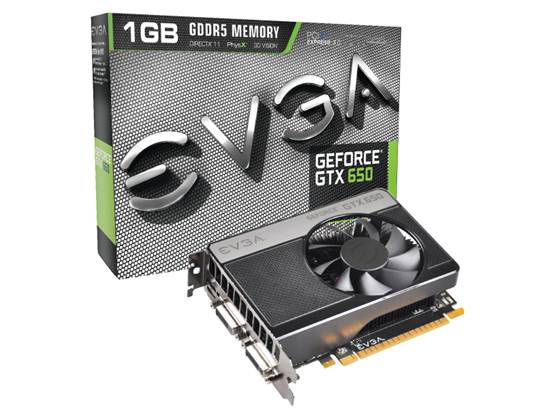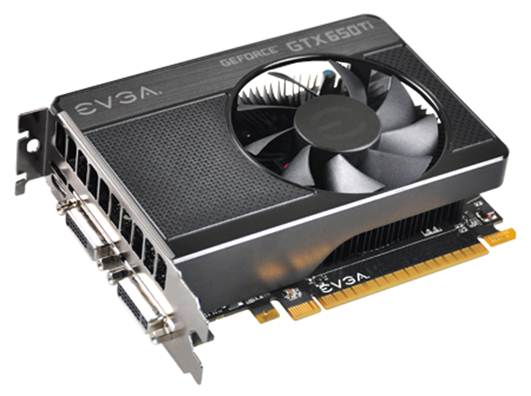At long last, NVidia drops its
current gen budget GPU
AMD's line-up of its current gen cards has
been more complete than NVidia's for some time now, thanks to cheaper cards like
the HD 7770 and 7750. However, with the release of both the GTX 660 and the GTX
650, NVidia is finally beginning to bring Kepler-Based cards to the mainstream.
The GTX 650's $144 price tag positions it in direct competition with AMD's HD
7770, which can now be found for this price.

EVGA
GeForce GTX 650 1GB
The GTX 650 has been quite severely cut
down from the more powerful NVidia cards like the GTX 660 Ti, but you'd expect
that given the sub-$160 price. Consequently, its GK107 GPU has only 1.3 billion
transistors, almost half that of the GTX 660. This is good news not only for
production costs but also for power consumption – the GTX 650 has a tiny TDP of
64 watts (although it still requires a PCI-E power connection).
The card is clocked at 1,058MHz, and since
NVidia's boost technology is also missing from it, you'll need to do some
manual overclocking if you want it to run any faster. Thankfully, the card
overclocks excellently – I was able to achieve a stable 20% overclock, a
brilliant result for such a budget card. The card features 1GB of memory
(although 2GB versions are available), and a memory bandwidth of 80GB/s, which
is a healthy 8GB/s more than the Radeon HD 7770.
BENCHMARKS – 3DMark11 Basic, Performance
Preset.
·
HD 7770: 3518
·
GTX 650: 3044
·
HD 7750: 2729
This particular version of the GTX 650 is
EVGA's, who have fitted their own cooling to the reference PCB; a dual-slot
heatsink draws heat away from both the GPU and the memory chips, and is cooled
by the single 80mm fan. The design of the heatsink means that the card will
exhaust most of its hot air into your case, so you'll need to make sure your
case is well ventilated before installing it. Nonetheless, the cooler does a
great job of keeping the hardware cool, and does so while remaining quiet too,
which is a nice bonus.
As you might assume, the GTX 650 isn't the
most feature-rich card. There's no support for SLI, for example, but then the
$289 GTX 660 would easily outperform two $144 GTX 650s in SLI. Those who like
to work with more than one monitor (and let's be honest, who doesn't?) are well
catered for, though, thanks to dual DVI ports and a single HDMI connection.

Graphics performance of cards under $160 is
never going to make your eyes bleed, but the GTX 650 can run Battlefield 3 with
(just) playable frame rates at 1920 x 1080, albeit with the settings toned down
a little, and this is no easy task for a card of this calibre. However, though
it has an edge on the cheaper HD 7750, AMD's HD 7770 is a faster card across
the board, yet costs the same. Only through overclocking the card to its
maximum potential will you be able to match the frame rates offered by the HD
7770. The GTX 650 definitely has some grunt to it, but in a market where every
extra pound counts, it finds itself struggling to justify its asking price. mm
Matthew Lambert
It's cheap, just not cheap enough
compared to the competition
|
Details
Price: $144
Manufacturer: EVGA
Website: www.eu.evga.com/default.asp
Required Spec: 2 x free PCI-E expansion slots,
1 x 6-pin PCI-E power connector
|